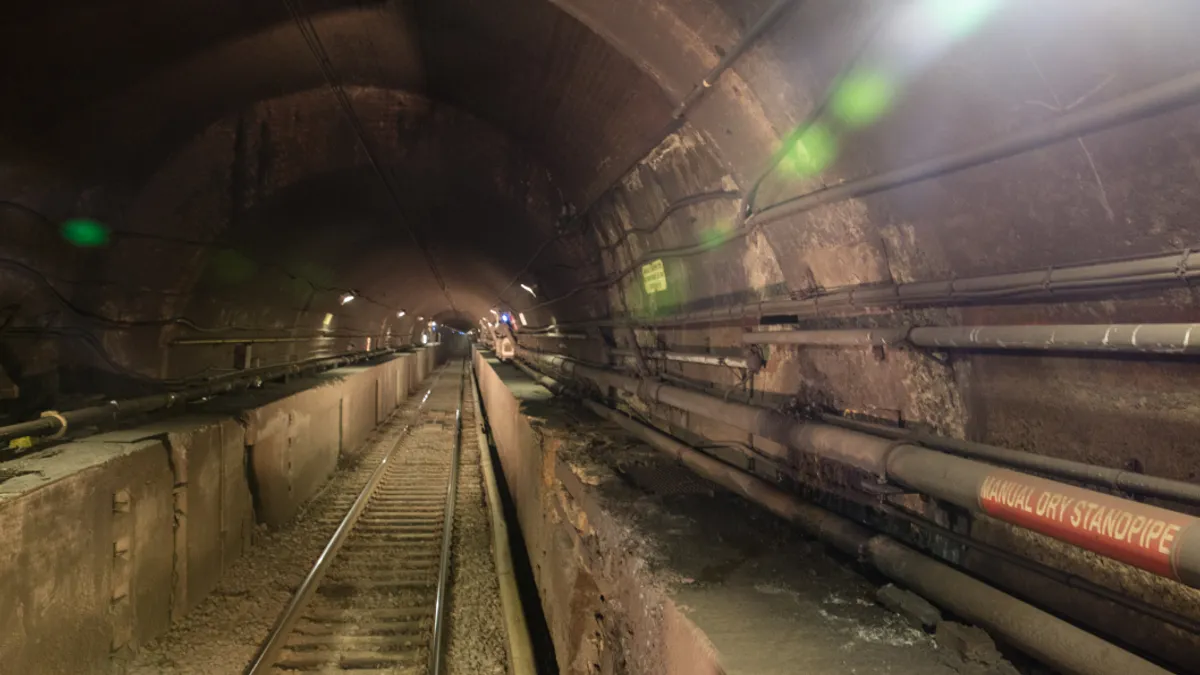Dive Brief:
- Construction of a proposed new rail tunnel system beneath the Hudson River could cost approximately $1.4 billion less than previously anticipated, according to the Gateway Program Development Corp. (GDC). The savings is due in part to the results of a “risk identification, contract packaging and delivery method analysis,” which unveiled efficiencies that could be gained from "bundling expected contract scopes of work into larger contract packages and utilizing design-build procurement to encourage innovative solutions."
- The revised cost of $9.5 billion for the new tunnel was included in an updated financial plan that the committee submitted to the Federal Transit Administration (FTA) on Aug. 23. The plan includes an increase in the cost of rehabilitating the existing, 108-year-old North River Tunnel system, from $1.6 billion to $1.8 billion, due to a delay in starting the project, which still needs federal permits to move ahead. The plan now totals $11.3 billion.
- Once the bidding process gets underway, the GDC team will likely favor design-build contracts, chief spokesman Stephen Sigmund said. Experience will also play a crucial role in the selection of contractors, he said. "For the ability to deliver the best value on what is going to be a huge, 100-year project, experience and competence are of the most importance," he told Construction Dive.
Dive Insight:
In the Aug. 23 letter to FTA Associate Administrator of Planning and Environment Felicia James, officials from the GDC — a partnership between New York, New Jersey and Amtrak — said they were able to trim costs on the project linking the two states because they have done more advance work since their original proposal last year. The effort has resulted in ways to mitigate unexpected expenses and lessen the amount of money needed to be set aside, they wrote.
For instance, the new tunnel’s design is 30% complete, compared to 10% in the original plan, Sigmund said.
The new plan includes a vote of confidence for a design-build path, with the letter saying that the lower projected cost is "based on a contract packaging solution that includes, as a first package, design-build procurement of the new tunnel’s civil works … to promote ultimate completion of the project more rapidly and at less cost.”
The GDA also intends to seek an Early Systems Work Agreement that would allow boring to commence even while the team is awaiting a full funding grant agreement. This move will save time and money “and provide a clear path for the completion of the remainder of the new tunnel and rehabilitation of the existing tunnel,” the plan reads.
Project members are hoping the lower pricetag will make the plan more attractive to federal officials, Sigmund said, adding that he does not know when the group will receive a response from the FTA.
“We've got to get a record of decision," he said. "We can't do some of the critical pathwork that's needed, like property acquisition, until that happens."
Earlier this year, President Donald Trump excluded federal funding for the project in his $4.7 trillion 2020 budget request to Congress.
The Gateway Program focuses on a 10-mile segment of the Northeast Corridor railway system, and includes a program of projects that would replace and update rail infrastructure assets that, in many cases, are over 100 years old, as well as increase track, tunnel, bridge and station capacity.
State and Amtrak officials have advocated for the Gateway Program for years, saying it would improve reliability while creating new capacity for a critical section of the Northeast Corridor, the most heavily used passenger rail line in the country. Approximately 400 trains and 200,000 passengers travel the Hudson River tunnel every day, according to the Associated Press, and a report from New Jersey Gov. Phil Murphy’s office pegs the regional and national economic impact of just a one-day shutdown of either of the tunnel’s two tubes at $100 million.












